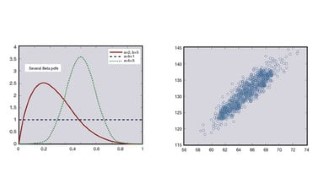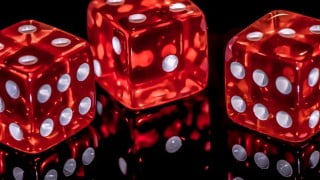Probability and Statistics II: Random Variables – Great Expectations to Bell Curves
Learn about properties and applications of random variables in this comprehensive course. Gain the skills needed for modeling and analysis problems.
What you will learn
- Lesson 1: Introduction (FCPS ?2.1)
- Lesson 2: Discrete Random Variables (FCPS ?2.2)
- Lesson 3: Continuous Random Variables (FCPS ?2.3)
- Lesson 4: Cumulative Distribution Functions (FCPS ?2.4)
- Lesson 5: Great Expectations (FCPS ?2.5.1)
- Lesson 6: LOTUS, Moments, and Varience (FCPS ?2.5.2)
- Lesson 7 [OPTIONAL]: Approximations to E[h(X)] and Var(h(X)) (FCPS ?2.5.3)
- Lesson 8: Moment Generating Functions (FCPS ?2.6)
- Lesson 9: Some Probability Inequalities (FCPS ?2.7)
- Lesson 10: Functions of a Random Variable (FCPS ?2.8.1)
- Lesson 11: Inverse Transform Theorem (FCPS ?2.8.2)
- Lesson 12 [OPTIONAL]: Honors Bonus Results (FCPS ?2.8.3)
- Lesson 1: Introduction (FCPS ??3.1.1?3.1.3)
- Lesson 2: Marginal Distributions (FCPS ?3.1.4)
- Lesson 3: Conditional Distributions (FCPS ?3.2)
- Lesson 4: Independent Random Variables (FCPS ?3.3.1)
- Lesson 5: Consequences of Independence (FCPS ?3.3.2)
- Lesson 6: Random Samples (FCPS ?3.3.3)
- Lesson 7: Conditional Expectation (FCPS ?3.4.1)
- Lesson 8: Double Expectation (FCPS ?3.4.2)
- Lesson 9 [OPTIONAL]: First-Step Analysis (FCPS ?3.4.3)
- Lesson 10 [OPTIONAL]: Random Sums of Random Variables (FCPS ?3.4.3)
- Lesson 11 [OPTIONAL]: Standard Conditioning Argument (FCPS ?3.4.3)
- Lesson 12: Covariance and Correlation (FCPS ?3.5.1)
- Lesson 13: Correlation and Causation (FCPS ?3.5.2)
- Lesson 14: A Couple of Worked Correlation Examples (FCPS ?3.5.3)
- Lesson 15: Some Useful Covariance / Correlation Theorems (FCPS ?3.5.4)
- Lesson 16: Moment Generating Functions, Revisited (FCPS ?3.6)
- Lesson 17 [OPTIONAL]: Honors Bivariate Functions of Random Variables (FCPS ?3.7)
Program Overview
This course discusses properties and applications of random variables. When you?re done, you?ll have enough firepower to undertake a wide variety of modeling and analysis problems; and you?ll be well-prepared for the upcoming Statistics courses.
We?ll begin by introducing the concepts of discrete and continuous random variables. For instance, how many customers are likely to arrive in the next hour (discrete)? What?s the probability that a lightbulb will last more than a year (continuous)?
We?ll learn about various properties of random variables such as the expected value, variance, and moment generating function. This will lead us to a discussion of functions of random variables. Such functions have many uses, including some wonderful applications in computer simulations.
If you enjoy random variables, then you?ll really love joint (two-dimensional) random variables. We?ll provide methodology to extract marginal (one-dimensional) and conditional information from these big boys. This work will enable us to
study the important concepts of independence and correlation.
Along the way, we?ll start working with the R statistical package to do some of our calculations and analysis.
User Reviews
Be the first to review “Probability and Statistics II: Random Variables – Great Expectations to Bell Curves”
You must be logged in to post a review.







There are no reviews yet.